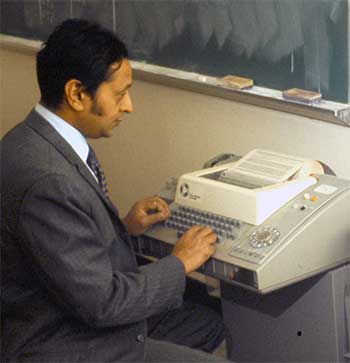
 |
|
Syed Salahuddin Hyder received a Ph.D. in Applied Mathematics/Engineering Science from McGill University in 1964 where he became an Associate Professor of Electrical Engineering. He won the NATO award for advanced research in Computer Science at the University of Michigan in Ann Arbor. On his return to McGill he initiated and worked on a project to set up Computer Science at the University. In 1966 he was requested to join the newly created department of Informatique (Computer Science) at the Universite de Montreal. As the first Professor in that discipline he planned and developed the program. Dr. Hyder was invited by the Université Paris VI (Pierre et Marie Curie) as a Senior Research Professor for the year 1973-74. Two years after his return from Paris, he was appointed full Professor of Computer Science at the Université de Montreal. In 1983 he took a position as full Professor of Computer Science at the King Fahd University of Petroleum and Minerals in Dhahran Saudi Arabia. In 1990 Dr. Hyder worked in Washington D.C. as Research Director on a National Institute of Health project on Computer Modeling of Human Genetics. He joined Concordia University in 1991, as a Visiting Scientist and Professor.

Currently he is Adjunct Professor of Computer Science at McGill University, of which he was one of the founders. He does research in Artificial Intelligence, Expert Systems and Mathematical Logic. Prof. Hyder has developed an AI based system for high quality calligraphic printing of AFU languages, the Naskh script for the Arabic language and the Nastalique script for the Farsi-Urdu language.
Prof. Hyder has the distinction of
pioneering in 1973, the theory and system for printing and communicating in
Arabic, Farsi and Urdu (AFU), family of languages. It was supported by the
International Development Research Center, in the development of bilingual
computer display terminals, tele-printers and typewriters to work simultaneously
in AFU languages and English. Prof. Hyder has to his credits over 20 patents and
several publications in this field.
The Arabic systems theory developed by Dr. Hyder is the basis of the ASMO standard, for Teleprinter and Computer Arabization. Technologies developed by Dr. Hyder have been licensed to several product manufacturers such as Siemens AG, AEG-Olympia Werke AG, Alis, Comterm, etc.
Dr. Hyder and his work on Arabization and Artificial Intelligence were presented to the highest authorities in Saudi Arabia by the Rector of the University of Petroleum and Minerals in Dhahran. He was given an award for research excellence at that University. On the occasion of Canadaís 125-year celebrations, he received an award for excellence in Academia and Research from the Canadian Government.
Syed Salahuddin Hyder (1930-2006)HYDER, Syed Salahuddin died in his sleep in the night of April 15, 2006 at the age of 76. Of a family of six children, he is survived only by his sister, Apa Humann of Rawalpindi, Pakistan. He will be missed by his children, Alexander, David and Ingrid, and their mother Dinah. Born in Nator, India, our father emigrated first to Pakistan and then to Canada, where he took his PhD in Mechanical Engineering at McGill University. After a series of positions in Chalk River, San Diego, and Ann Arbour, he continued his research career as an Assistant Professor at McGill, moving on from there to become Professor of Computer Science at the University of Montreal. In later years, he was a visiting Professor in Saudi Arabia and Pakistan. His work, which was the centre of his life, focused on applied mathematics and the theory of computation. He was actively engaged in research until the day he died. He was buried at the Islamic Cemetery of Quebec. |
|
Syed Hyder est né à Nator dans la partie de l'Inde qui est devenue le Pakistan Oriental après la partition de l'Inde en 1947 puis le Bangladesh. Il a reçu son premier diplôme universitaire, un BSc en Physique, du Aligarh Muslim University avant d'émigrer au Canada et de faire un doctorat à McGill. Il a été parmi nous pendant plus de 15 ans de 1966 à 1983. Durant ce temps, il s'est lancé corps et âme dans l'"arabisation" de l'informatique à une époque où le monde arabe commençait à s'affirmer (et avant que les intégristes prennent le dessus). Il a développé un terminal arabe au DIRO à une époque ou nos imprimantes (de la cyber) avaient de la peine à traiter des caractères accentués (et même les minuscules).
Son idée pour le terminal était la suivante: l'alphabet arabe a (à peu près) le même alphabet que le nôtre mais chacune des 26 quelques lettres a 4 formes différentes. Avec les caractères de 6 ou 7 bits de l'époque, on ne pouvait pas stocker toutes les formes. Donc on stocke juste une forme de lettre et a l'impression, le terminal utilise un automate qui décide de la bonne forme pour chaque lettre dépendant du contexte. Dans le cas du prototype du DIRO, l'imprimante était une Selectric d'IBM avec une boule arabe avec tous les "gliphs". Suite à ça, Syed a créé ALIS (Arab Latin Information Systems) une compagnie qui existe toujours. Son invention est décrite dans le brevet canadien No. 1,044,806 (1978). Pour des gens de culture "arabe", cette époque était aussi grisante que la Révolution Tranquille au Québec et notre lutte pour la reconnaissance du Français. Afin de pousser ses idées, Syed a dû passer beaucoup de temps à l'étranger - en particulier en Iran (avant l'ayatollah), en Arabie Saoudite, au Pakistan et en Europe.... trop peut-être et son enseignement en a souffert. Il en demeure que c'est un rare collègue à avoir inventer qqc de pertinence mondiale. Ces dernières années, il partageait son temps entre Montréal et le NED University of Engineering and Technology à Karachi au Pakistan.
Jean Vaucher
|